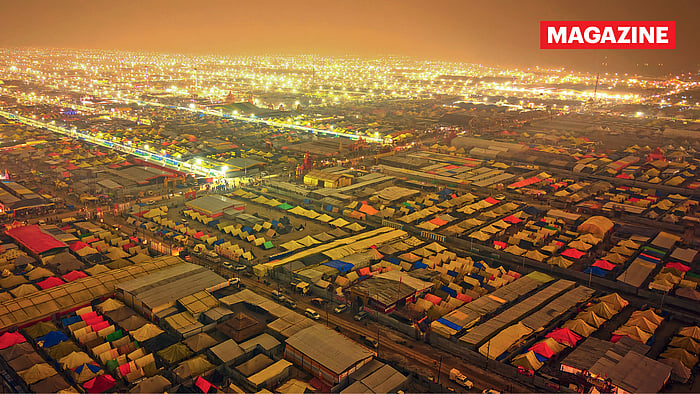WHEN AMIT SAXENA decided to set up a food stall of Kakis Caterers at the Kumbh Mela, little did he know of what lay ahead. Saxena set up two stalls of 1,000 sq. ft each, with a seating capacity of around 400 people, serving thalis, kachoris and tea for the “hi-fi gentry,” as Saxena likes to call them. Backed by Brooke Bond, Saxena made a personal investment of ₹90 lakh in the project, his first-ever at Kumbh.
Saxena is among thousands of entrepreneurs lining up at Kumbh to cash in on the ₹2-lakh-crore opportunity, according to industry body Confederation of All India Traders (CAIT). However, the foray into one of the world’s largest spiritual gatherings has so far turned out to be an uphill battle.
“We anticipated a crowd of 500 million, but the reality has been different,” says Saxena. Despite the festival’s grandeur and scale, medium-size ventures like Saxena’s have struggled to make a mark in a space largely dominated by big caterers or local vendors or the bhandaras. “It’s the larger players who walk away with the profits,” he adds. Even subtle choices such as upgrading the carpet for a more premium feel count. “If the set-up feels too extravagant, it discourages customers. People are here for an experience, not opulence,” he remarks.
The story of Saxena’s Kumbh journey is a glimpse into the complex interplay of scale, tradition, and commerce at an event of such a scale. Maha Kumbh 2025 is said to be the first occurrence in 144 years, a spiritual congregation for celebrating the confluence of three auspicious rivers in the Hindu tradition — Ganga, Yamuna, and the mythical Saraswati — spread over 45 days, from January 13 to February 26.
No wonder, FMCG giants, tech start-ups, and fintech firms are seizing the opportunity. A hospitality agent told Fortune India the festival hosts five food courts, with 14 outlets, including Starbucks and Domino’s. Blinkit, too, has set up a 100 sq. ft. dark store for essentials, while PhonePe is offering insurance services.
“ITC’s FMCG brands, including Bingo! and Mangaldeep, are leveraging this opportunity to connect with the masses through experiential initiatives. Agarbatti brand Mangaldeep will complement the festival (spirit) through brand participation in rituals, including havans, hosting evening bhajans, and offering digital engagement through augmented reality,” an ITC spokesperson said.
Companies are seeing strong engagement in return. “The response has been good in terms of both visibility and revenue. It’s a great place for any brand to be in. We had a good amount of footfall, and we’ve had good people coming,” a spokesperson from Reliance Consumer, which is present on-ground through carbonated drinks, snacks, told Fortune India. RIL is providing pilgrims with a variety of services, including nourishing meals and essential healthcare to safe transportation and seamless connectivity.
Innovation is in focus, with companies such as Coca-Cola and SLMG Beverages digitising the experience through hydration carts and selfie zones. Chai Point is serving robot-made tea at its pop-up stores.
“The infrastructure that’s already set up will benefit local business owners. Homeowners have also turned their homes into hotels. The prices of everything have quadrupled, so local business will thrive,” says Vikrant Badera of Tanish Foods, which has set up a food court with 25 stalls, each leased out for ₹2 lakh.
Over ₹28 lakh in sales were recorded at the ‘One District-One Product’ exhibition on Makar Sankranti alone, with micro-units receiving orders worth ₹10,000 crore.
Travel aggregator Ixigo, meanwhile, has observed an unprecedented rise in demand for Maha Kumbh 2025. Currently, there are 132 flights operating monthly to Prayagraj from across India. Affordable accommodations, especially those priced under ₹10,000, have been sold out, especially during key bathing dates, says Manan Bajoria, group vice president, growth marketing, Ixigo. More than 400 million people are expected to attend Kumbh, 50% of whom are tourists with disposable incomes, says Eesha Priya of the UP tourism department. However, crowd management remains a challenge.
Source:https://www.fortuneindia.com/long-reads/the-economics-of-maha-kumbh-heres-how-the-mega-45-day-event-can-help-indias-economy/120579

